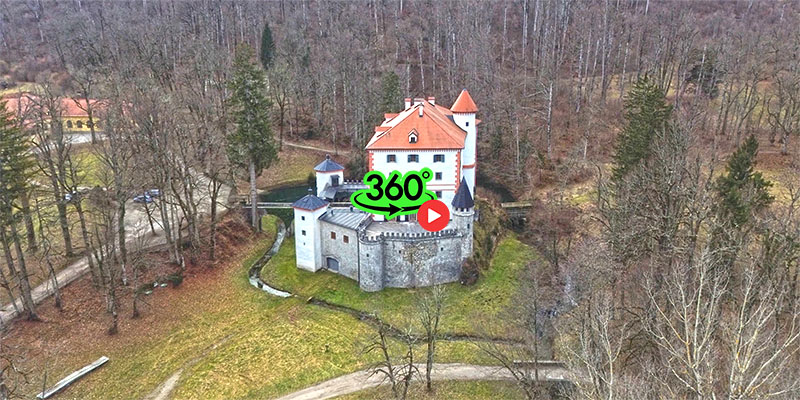Snežnik castle is situated near the Kozarišče
village - about 2.5 km southern from the Lož (28 km ES from the Cerknica
lake). Nearby the castle is the higest Slovenian mountin which is not in Alps -
Snežnik
. The name "Snowy mountain" (Schneeberg - Snežnik) was first mentioned
in 1461 but the first written documents about the castle are from 1269.
Interior from the 19th century
is very well preserved. Beside the castle is a landscape park which is
a part of the "Snežnik Castle Regional Park". The castle is open for a public as a castle museum of the National museum of Slovena.

After a restoration completed in 2008, the romantic state-owned Snežnik Castle in Notranjska, the only one in Slovenia with surviving authentic interiors, has again been open to the public.
At a nearby strategic site on the edge of the Lož Valley, a stronghold was already built by the Romans. The lords of Snežnik (= The Snowy one) are first mentioned in the 13th century. The castle's successive owners were members of eminent Carniolan noble families, the Lambergs, Scheyers, Raumschissls, Eggenbergs, Auerspergs and Lichtenbergs. In the 17th century a large part of Notranjska was governed from Snežnik. The medieval stronghold was repeatedly refurbished, with renaissance and baroque features, including the surviving fetching beamed ceilings. Its present appearance dates from the latter half of the 19th century. After the estate with its immense forests had been bought in 1853 by a princely Saxon family of Schönburg-Waldenburg, the castle was converted into a hunting and holiday residence. In 1867 Prince George backed the foundation in the grounds of the first Slovenian forestry school. Rare animals were not hunted and the steam saw spurred the development of woodworking industry in the valley. The expertly managed property offered a range of jobs to the locals until the end of the second world war when the last caretaker Leon Schauta saved the building from destruction.
A stroll through the four floors of the castle evokes the atmosphere of more than a hundred years ago. Rooms are equipped with genuine furniture and other household objects from the latter half of the 19th century. The drawing rooms and bedrooms of Princes Herman and Ulrich, of Princess Anne and the guest rooms are handsomely and comfortably fitted out with originally upholstered historicist seating suites and ornamental stoves. Walls are hung with family portraits, old photos and prints. Outstanding is the Egyptian room from the early 20th century. The piano, the billiard table and the theatre corner disclose the owners' pastimes. Gradually, an interesting collection of hunting trophies was assambled, notably the stuffed bear. In the lobby there are Roman tombstones and a large 1744 printed map of Carniola. Remarkable is a 17th century ornamental leather antependium from the neighbouring village church of Šmarata. Temporary exhibitions are held in the stonefaced bailey area and a ground floor room is used for wedding ceremonies. Outside under the hanging wooden gangway is kept a dugout boat, such as were used by the locals to cross flooded grasslands.

The imposing whitewashed castle, quietly reflected in the spring water of the pond alive with bleak, trout and ducks, is surrounded by a large, partly restored park with tree-lined walks and clearings. In the pleasant summer shade among the trees one might come across a statue of Diana. The countryside is breathtaking in any season, including in winter with enchanting mists dancing above frozen-over maddows. Right by the castle run two hiking routes, the European 6th and the local Krpan's route. The landscape is also great for biking and horse-riding. A few kilometres away is the stunning cave Križna jama.
Today Snežnik Castle on the verge of vast pine-and-beech forests is far from noisy thoroughfares and an ideal point of departure for exploring the beautiful Karst countryside. From here woodlands spread out, to the south right up to the picturesque name-sake mountain of Snežnik close to the Croatian border, and to the east to the ancient Kočevje forests, forming one of the last remaining European massive woodland regions. This unique natural environment is home to a plethora of flora and fauna, from bears, boars, wolves and lynxes, to wild fowl, small game and deer. (source: Narodni muzej Slovenije, URL: https://www.nms.si/, January 1st 2015)

